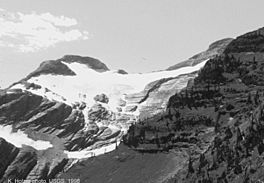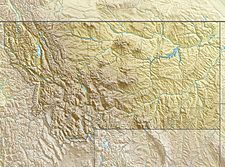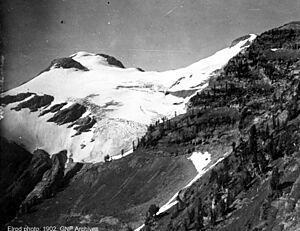Grant Glacier facts for kids
Quick facts for kids Grant Glacier |
|
|---|---|

Grant Glacier as seen in 1998
|
|
| Type | Cirque glacier |
| Location | Flathead County, Montana, U.S. |
| Coordinates | 48°19′24″N 113°45′06″W / 48.32333°N 113.75167°W |
| Area | 83 acres (34 ha) (in 1995) |
| Length | .25 mi (0.40 km) |
| Terminus | Barren rock |
| Status | Retreating |
Grant Glacier is a cool natural ice formation located in the United States state of Montana. You can find it within the Flathead National Forest, which is a big protected area. This glacier sits in a special bowl-shaped hollow called a cirque, right below the eastern slopes of Mount Grant. Mount Grant is a tall peak, standing at about 8,590 feet (2,618 meters) high.
Grant Glacier is not alone! It's about 1 mile (1.6 km) southeast of another glacier called Stanton Glacier. Both of these glaciers are also about 5 miles (8 km) west of the famous Glacier National Park (U.S.).
What is a Glacier?
A glacier is like a very slow-moving river of ice. It forms over many years as snow falls and gets packed down. This packed snow turns into ice. When enough ice builds up, gravity makes it slowly flow downhill. Glaciers are important because they store a lot of the world's fresh water. They also shape the land around them as they move.
Where is Grant Glacier?
Grant Glacier is found in the beautiful mountains of Montana. It's part of the Rocky Mountains, which stretch across North America. Being in a national forest means the area around the glacier is protected. This helps keep the natural environment safe for animals and plants.
Grant Glacier is Shrinking
Scientists have been watching Grant Glacier for a long time. They have pictures of the glacier from 1902 and then again from 1998. When they compare these pictures, it's clear that the glacier has gotten much smaller. This process is called "retreating."
A glacier retreats when more ice melts away than is added by new snowfall. Many glaciers around the world are retreating. This is often due to changes in Earth's climate, like warmer temperatures. When glaciers shrink, it can affect local water supplies and ecosystems.



